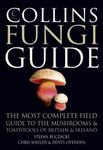Field / Identification Guide
Out of Print
By: Lars Svensson(Author), Killian Mullarney(Illustrator), Dan Zetterström(Illustrator), Peter J Grant(Contributor), David A Christie(Translated by)
448 pages, 3500 colour illustrations, 700 colour distribution maps
The superb Mullarney and Zetterström plates at full size
![Collins Bird Guide: Large Format Collins Bird Guide: Large Format]()
Click to have a closer look
About this book
Related titles
Recommended titles
About this book
Following on from its hugely successful launch in 1999, Collins Bird Guide – the ultimate reference book for bird enthusiasts – now enters its second edition. This enlarged reprint of the second edition has expanded text and additional colour illustrations, and is a must for every birdwatcher. Collins Bird Guide provides all the information needed to identify any species at any time of the year, covering size, habitat, range, identification and voice.
Accompanying every species entry is a distribution map and illustrations showing the species in all the major plumages (male, female, immature, in flight, at rest, feeding: whatever is important). In addition, each group of birds includes an introduction which covers the major problems involved in identifying or observing them: how to organise a sea watching trip, how to separate birds of prey in flight, which duck hybrids can be confused with which main species. These and many other common birdwatching questions are answered. The combination of definitive text, up-to-date distribution maps and superb illustrations, all in a single volume, makes Collins Bird Guide the ultimate field guide, essential on every bookshelf and birdwatching trip.
Customer Reviews
Field / Identification Guide
Out of Print
By: Lars Svensson(Author), Killian Mullarney(Illustrator), Dan Zetterström(Illustrator), Peter J Grant(Contributor), David A Christie(Translated by)
448 pages, 3500 colour illustrations, 700 colour distribution maps
The superb Mullarney and Zetterström plates at full size
"The combination of definitive text, up-to-date distribution maps and superb illustrations, all in a single volume, makes this book the ultimate field guide, essential on every bookshelf and birdwatching trip."
– The Birdbooker Report
"[...]This large format edition really is a must-own book, even if you have already purchased a copy of the second edition. Whilst the text largely remains the same as in the pocket-sized second edition, the large format version is all about the artwork. The new plates and updates introduced in 2009 suddenly spring to life [...] The large format edition takes an already superb book to the next level."
– Birding World Issue 298, 24(10), November 2011
"[...] The hardcovers are essentially enlarged versions of the softcovers (which were actually published first). The main problem with the paperback is that it is cramped for space. The font size is fairly small and could be a problem for some people to read. The number of species covered, the incredible amount of information given, and the desire to make it portable ensures that this issue was unavoidable. The hardcover edition is nearly three times larger, thus eliminating this concern. Additionally, the artwork is also larger and has more room to breath, making it even more spectacular. Reading and studying the larger edition is simply easier and much more enjoyable. But of course the increase in size and weight means that it is not practical to carry into the field while birding.
Recommendations for this guide are very simple. If you will be birding in Europe, without any doubt you absolutely should have this field guide. I would even take this a step further. Every birder who regularly encounters even some of the birds covered here, or might find one as a vagrant, should own this book. That definitely includes everyone in North America, as many of our difficult species, such as gulls and shorebirds, are included. The next decision is which version to get. I would suggest that everyone get at least the hardcover. The larger format just does wonders for the art, and it is much easier to scrutinize and study. And then anyone needing to use the guide in the field should also have the smaller paperback.
I cannot state that this is the best field guide in the world, or even for Europe (this is the only modern European guide that I have). But I have no problem stating that this and the North American Sibley Guides are easily the best field guides that I have seen."
– Grant McCreary (13-11-2007), read the full review at The Birder's Library









![Guida degli Uccelli d'Europa, Nord Africa e Vicino Oriente: Formato Grande [Collins Bird Guide: Large Format] Guida degli Uccelli d'Europa, Nord Africa e Vicino Oriente: Formato Grande [Collins Bird Guide: Large Format]](http://mediacdn.nhbs.com/jackets/jackets_resizer/23/233505.jpg)
![Der Kosmos-Vogelführer (Große Ausgabe): Alle Arten Europas, Nordafrikas und Vorderasiens [Collins Bird Guide: Large Format: The Most Complete Guide to the Birds of Britain and Europe] Der Kosmos-Vogelführer (Große Ausgabe): Alle Arten Europas, Nordafrikas und Vorderasiens [Collins Bird Guide: Large Format: The Most Complete Guide to the Birds of Britain and Europe]](http://mediacdn.nhbs.com/jackets/jackets_resizer/20/202020.jpg)


























